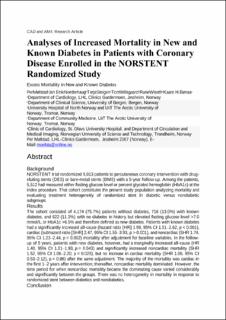| dc.description.abstract | Background: NORSTENT trial randomized 9,013 patients to percutaneous coronary intervention with drug-eluting stents (DES) or bare-metal stents (BMS) with a 5-year follow-up. Among the patients, 5,512 had measured either fasting glucose level or percent glycated hemoglobin (HbA1c) at the index procedure. That cohort constitutes the present study population analyzing mortality and evaluating treatment heterogeneity of randomized stent in diabetic versus nondiabetic subgroups. Results: The cohort consisted of 4,174 (75.7%) patients without diabetes, 716 (13.0%) with known diabetes, and 622 (11.3%) with no diabetes in history but elevated fasting glucose level >7.0 mmol/L or HbA1c >6.5% and therefore defined as new diabetes. Patients with known diabetes had a significantly increased all-cause (hazard ratio [HR] 1.99, 95% CI 1.51–2.62, p < 0.001), cardiac (subhazard ratio [SHR] 2.47, 95% CI 1.55–3.93, p < 0.001), and noncardiac (SHR 1.74, 95% CI 1.23–2.44, p = 0.002) mortality after adjustment for baseline variables. In the follow-up of 5 years, patients with new diabetes, however, had a marginally increased all-cause (HR 1.40, 95% CI 1.01–1.93, p = 0.043) and significantly increased noncardiac mortality (SHR 1.52, 95% CI 1.06–2.20, p = 0.025), but no increase in cardiac mortality (SHR 1.06, 95% CI 0.53–2.12, p = 0.86) after the same adjustment. The majority of the mortality was cardiac in the first 1–2 years after intervention; thereafter, noncardiac mortality dominated. However, the time period for when noncardiac mortality became the dominating cause varied considerably and significantly between the groups. There was no heterogeneity in mortality in response to randomized stent between diabetics and nondiabetics. Conclusion: Known diabetes has increased cardiac and noncardiac mortality in contrast to new diabetes which is only associated with increased noncardiac mortality during the 5-year follow-up. Diabetic and nondiabetic patients have the same response to the treatment with BMS or DES. | en_US |
